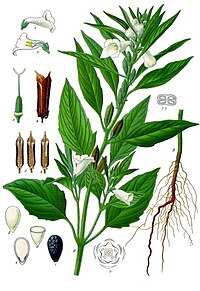
Photo from wikipedia
Pomegranate leaf (PGL) has a definite role in regulating lipid metabolism. However, pharmacokinetic results show the main active ingredient, ellagic acid, in PGL has lower oral bioavailability, suggesting that the… Click to show full abstract
Pomegranate leaf (PGL) has a definite role in regulating lipid metabolism. However, pharmacokinetic results show the main active ingredient, ellagic acid, in PGL has lower oral bioavailability, suggesting that the lipid-lowering effect of PGL may act through inhibiting lipid absorption in the small intestine. Our results demonstrated that pomegranate leaf and its main active ingredients (i.e., ellagic acid, gallic acid, pyrogallic acid and tannic acid) were capable of inhibiting pancreatic lipase activity in vitro. In computational molecular docking, the four ingredients had good affinity for pancreatic lipase. Acute lipid overload experiments showed that a large dosage of PGL significantly reduced serum total cholesterol (TG) and triglycerides (TC) levels in addition to inhibiting intestinal lipase activity, which demonstrated that PGL could inhibit lipase activity and reduce the absorption of lipids. We also found that PGL could reverse the reduced tight-junction protein expression due to intestinal lipid overload, promote Occludin and Claudin4 expression in the small intestine, and enhance the intestinal mucosal barrier. In conclusion, we demonstrated that PGL can inhibit lipid absorption and reduce blood TG and TC by targeting pancreatic lipase, promoting tight-junction protein expression and thereby preventing intestinal mucosa damage from an overload of lipids in the intestine.
Journal Title: Chinese journal of natural medicines
Year Published: 2017
Link to full text (if available)
Share on Social Media: Sign Up to like & get
recommendations!